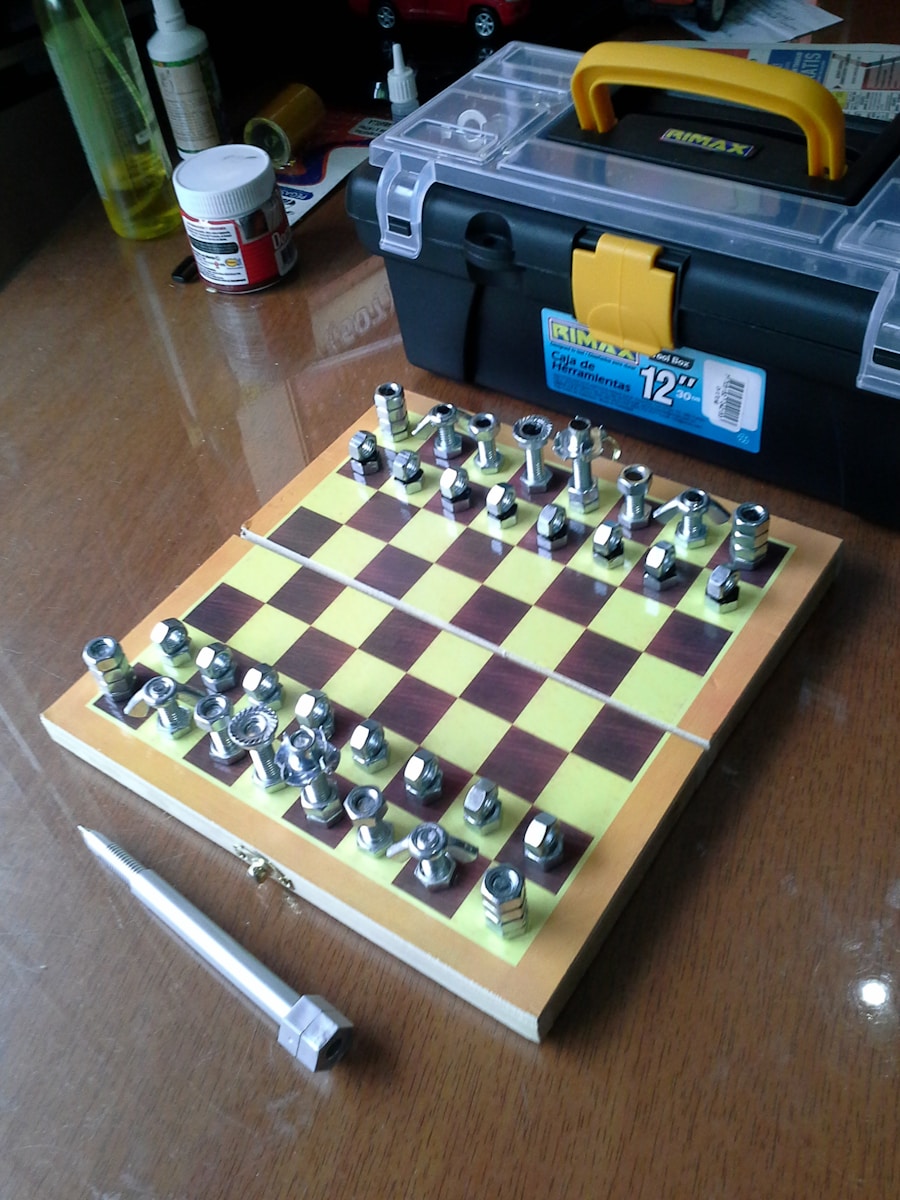Download links
How to install Mastering Chess Strategy: A Guide to Strategic Thinking in the Game of Kings APK?
1. Tap the downloaded Mastering Chess Strategy: A Guide to Strategic Thinking in the Game of Kings APK file.
2. Touch install.
3. Follow the steps on the screen.
Description
Chess strategy is a multifaceted discipline that encompasses a variety of principles and concepts aimed at achieving victory on the board. At its core, chess strategy involves the long-term planning and positioning of pieces to create advantageous situations while simultaneously thwarting the opponent’s plans. One of the fundamental aspects of chess strategy is the concept of piece activity.
Active pieces control more squares and exert greater influence over the board, which can lead to tactical opportunities and positional advantages. For instance, a knight on an advanced outpost can dominate the center, while a rook on an open file can threaten the opponent’s position. Another critical element of chess strategy is pawn structure.
The arrangement of pawns can dictate the flow of the game, influencing both offensive and defensive capabilities. Weak pawns, such as isolated or doubled pawns, can become targets for attack, while strong pawn formations can create barriers that restrict the opponent’s piece mobility. Understanding how to manipulate pawn structures is essential for any player aspiring to improve their strategic acumen.
For example, in the French Defense, Black often accepts a somewhat cramped position with the aim of counterattacking against White’s center later in the game. This illustrates how strategic decisions regarding pawn structure can shape the entire course of a match.
Key Takeaways
- Understanding the basics of chess strategy is crucial for developing a strong foundation in the game.
- Developing a solid opening repertoire is essential for gaining an early advantage and controlling the game.
- Mastering the art of positional play involves understanding the strengths and weaknesses of different pieces and controlling key squares on the board.
- Utilizing tactical maneuvers to gain an advantage involves recognizing and capitalizing on opportunities to capture or threaten opponent’s pieces.
- Creating and executing long-term plans is important for maintaining a strategic advantage and achieving victory in the endgame.
- Adapting to dynamic game situations requires flexibility and the ability to adjust strategies based on the changing circumstances of the game.
Developing a Solid Opening Repertoire
A well-rounded opening repertoire is crucial for any chess player looking to enhance their performance. The opening phase of the game sets the stage for the middlegame and can significantly influence the outcome. Players must familiarize themselves with various openings, understanding not only the moves but also the underlying ideas and plans associated with each.
For instance, the Ruy Lopez is a classic opening that emphasizes control of the center and piece development, while the Sicilian Defense offers Black dynamic counterplay and asymmetrical positions. When developing an opening repertoire, it is essential to strike a balance between familiarity and flexibility. Players should choose openings that resonate with their style while also being adaptable to different opponents.
This means studying not just the main lines but also potential transpositions and variations that may arise during play. For example, a player who enjoys tactical skirmishes might gravitate towards the King’s Indian Defense, which often leads to sharp positions filled with tactical opportunities. Conversely, a player who prefers solid structures might opt for the Queen’s Gambit Declined, focusing on maintaining a robust pawn structure while gradually improving piece placement.
Mastering the Art of Positional Play

Positional play in chess refers to a style of play that emphasizes long-term advantages over immediate tactical gains. It involves evaluating the strengths and weaknesses of both players’ positions and making strategic decisions based on this analysis. A key aspect of positional play is understanding piece coordination and how to maximize each piece’s potential.
For instance, rooks are most effective when placed on open files or ranks, where they can exert pressure on the opponent’s position. Similarly, bishops thrive on long diagonals, where they can control significant portions of the board. Another important consideration in positional play is pawn structure.
Players must assess their own pawn formation while also considering their opponent’s structure. A well-placed pawn chain can restrict an opponent’s pieces and create weaknesses that can be exploited later in the game. For example, in a closed position, players may focus on maneuvering their pieces to improve their overall coordination while waiting for an opportunity to break through. This contrasts with more tactical positions where immediate calculations take precedence.
Mastering positional play requires patience and a deep understanding of how various elements interact on the board.
Utilizing Tactical Maneuvers to Gain an Advantage
| Tactical Maneuver | Advantage Gained |
|---|---|
| Flanking | Surprise attack on enemy’s side or rear |
| Ambush | Gain element of surprise by hiding and attacking |
| Decoy | Divert enemy’s attention to create an opening |
| Feint | Trick opponent into a false move or attack |
Tactics are often considered the lifeblood of chess; they represent short-term calculations that can lead to immediate gains in material or position. Recognizing tactical opportunities requires sharp calculation skills and an awareness of common tactical motifs such as forks, pins, skewers, and discovered attacks. For instance, a knight fork can simultaneously attack two pieces, forcing an opponent to make a difficult decision about which piece to save.
Similarly, a pin can immobilize an opponent’s piece, making it vulnerable to attack. To effectively utilize tactical maneuvers, players must engage in regular practice and study of tactical puzzles. This not only sharpens calculation skills but also helps players recognize patterns that frequently occur in games.
For example, many players find themselves in positions where a discovered attack can be executed by moving one piece out of the way to reveal an attack from another piece behind it. By training their minds to spot these patterns quickly, players can capitalize on tactical opportunities as they arise during actual games.
Creating and Executing Long-term Plans
Creating long-term plans in chess involves setting strategic goals based on an assessment of the position and then executing those plans through careful maneuvering and piece coordination. A successful long-term plan often begins with identifying weaknesses in the opponent’s position—such as poorly placed pieces or vulnerable pawns—and then formulating a strategy to exploit those weaknesses over time. For example, if one player has doubled pawns on one side of the board, an effective plan might involve targeting those pawns while simultaneously improving one’s own piece activity.
Execution of long-term plans requires flexibility and adaptability; as the game progresses, new information will emerge that may necessitate adjustments to one’s strategy. Players must remain vigilant and be prepared to pivot if their initial plan becomes untenable due to unforeseen developments or counterplay from their opponent. This dynamic nature of chess means that while long-term planning is essential, it must be balanced with an acute awareness of current threats and opportunities on the board.
Adapting to Dynamic Game Situations

Chess is inherently a dynamic game where situations can change rapidly based on each player’s moves. Adapting to these changes is crucial for success at all levels of play. A player must be able to assess not only their own position but also their opponent’s intentions and potential responses.
This requires a keen understanding of both strategic principles and tactical possibilities. For instance, if an opponent suddenly launches an aggressive attack against your king, it may be necessary to shift focus from your original plan to defensive measures that ensure survival. Moreover, adapting to dynamic situations often involves recognizing when to transition between different phases of the game—moving from opening principles into middlegame strategies or transitioning into endgame techniques as material simplifies.
For example, in endgames, king activity becomes paramount; thus, players must be prepared to activate their kings while simplifying into favorable endgame positions. In conclusion, mastering chess requires a deep understanding of various strategic concepts ranging from openings to endgames.
Each aspect plays a vital role in shaping a player’s overall approach to the game, allowing them to navigate complex positions with confidence and skill. By developing a solid foundation in these areas, players can enhance their ability to adapt and thrive in the ever-changing landscape of chess.
If you are a chess enthusiast looking to improve your game, you may want to check out this article on Marvel Batalla de Superheroes 2. While it may not seem directly related to chess, the strategic thinking and decision-making skills required in superhero battles can also be applied to the game of chess. By honing your strategic abilities in different contexts, you can become a more well-rounded and skilled chess player.
FAQs
What is chess?
Chess is a two-player strategy board game that is played on an 8×8 grid. It is one of the most popular and enduring games in the world, with a rich history dating back over 1500 years.
How is chess played?
Chess is played on a square board divided into 64 squares, with each player starting with 16 pieces: one king, one queen, two rooks, two knights, two bishops, and eight pawns. The objective of the game is to checkmate the opponent’s king, which means putting the king into a position where it cannot escape capture.
What are the basic rules of chess?
Each type of chess piece moves in a specific way: the king moves one square in any direction, the queen moves any number of squares in any direction, the rook moves any number of squares horizontally or vertically, the bishop moves any number of squares diagonally, the knight moves in an L-shape, and the pawn moves forward one square and captures diagonally. The game ends when a player’s king is in checkmate, or when a stalemate is reached.
What are the benefits of playing chess?
Chess has been shown to have numerous cognitive benefits, including improving memory, concentration, problem-solving skills, and strategic thinking. It is also a great way to improve patience and decision-making abilities.
What is the history of chess?
Chess originated in India around the 6th century and spread to Persia, where it became known as “shatranj.” It then spread to the Arab world and Europe, evolving into the modern game of chess that we know today. Chess has a rich and storied history, with many famous players and memorable games.





